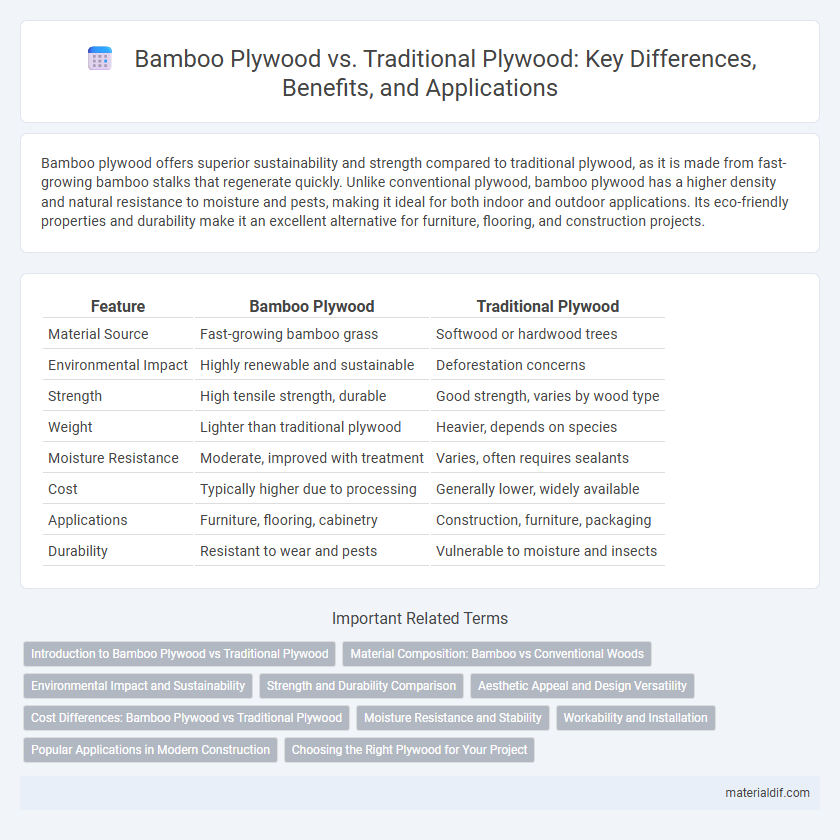Bamboo plywood offers superior sustainability and strength compared to traditional plywood, as it is made from fast-growing bamboo stalks that regenerate quickly. Unlike conventional plywood, bamboo plywood has a higher density and natural resistance to moisture and pests, making it ideal for both indoor and outdoor applications. Its eco-friendly properties and durability make it an excellent alternative for furniture, flooring, and construction projects.
Table of Comparison
| Feature | Bamboo Plywood | Traditional Plywood |
|---|---|---|
| Material Source | Fast-growing bamboo grass | Softwood or hardwood trees |
| Environmental Impact | Highly renewable and sustainable | Deforestation concerns |
| Strength | High tensile strength, durable | Good strength, varies by wood type |
| Weight | Lighter than traditional plywood | Heavier, depends on species |
| Moisture Resistance | Moderate, improved with treatment | Varies, often requires sealants |
| Cost | Typically higher due to processing | Generally lower, widely available |
| Applications | Furniture, flooring, cabinetry | Construction, furniture, packaging |
| Durability | Resistant to wear and pests | Vulnerable to moisture and insects |
Introduction to Bamboo Plywood vs Traditional Plywood
Bamboo plywood is engineered from thin layers of bamboo veneer laminated together, offering superior strength and eco-friendliness compared to traditional plywood made from hardwood or softwood veneers. Its rapid growth and renewability make bamboo plywood a sustainable alternative, often exhibiting higher durability, resistance to warping, and improved moisture resistance. Traditional plywood remains widely used due to its versatility and established availability, but bamboo plywood is gaining popularity in applications demanding greener materials and enhanced mechanical properties.
Material Composition: Bamboo vs Conventional Woods
Bamboo plywood is crafted from laminated bamboo strips, offering a denser and more uniform grain structure compared to traditional plywood made from layers of hardwood or softwood veneers. The natural cellulose fibers in bamboo provide enhanced tensile strength and flexibility, while conventional plywood relies on tree species like pine, oak, or birch that vary in density and grain consistency. This distinct material composition results in bamboo plywood being more sustainable, resistant to warping, and environmentally friendly due to bamboo's rapid growth rate and renewable harvesting.
Environmental Impact and Sustainability
Bamboo plywood offers a significantly lower environmental impact compared to traditional plywood by utilizing fast-growing bamboo, which regenerates within 3 to 5 years, unlike hardwood trees that take decades to mature. Its sustainable harvesting practices reduce deforestation, and bamboo's natural resistance to pests lessens the need for harmful chemical treatments found in conventional plywood. Bamboo plywood also has a higher carbon sequestration rate, making it a more eco-friendly material for environmentally conscious construction and furniture projects.
Strength and Durability Comparison
Bamboo plywood exhibits superior strength and durability compared to traditional plywood due to its dense fiber structure and natural flexibility. Its tensile strength often surpasses conventional wood plywood, making it highly resistant to warping, cracking, and moisture damage. These qualities make bamboo plywood an ideal material for high-stress applications in construction and furniture manufacturing.
Aesthetic Appeal and Design Versatility
Bamboo plywood offers a unique aesthetic appeal characterized by its natural, warm tones and distinctive grain patterns that enhance modern and rustic interiors alike. Its design versatility allows for seamless customization, accommodating intricate cuts and diverse finishes that traditional plywood may not easily support. Compared to conventional plywood, bamboo plywood provides a more sustainable and visually striking option for innovative architectural and furniture designs.
Cost Differences: Bamboo Plywood vs Traditional Plywood
Bamboo plywood typically costs more than traditional plywood due to its sustainable harvesting and rapid growth cycle, which requires specialized processing techniques. Traditional plywood is generally cheaper because it is mass-produced from slower-growing hardwoods or softwoods with established supply chains. Long-term investment in bamboo plywood can result in cost savings through its durability and resistance to moisture and pests, reducing maintenance and replacement expenses.
Moisture Resistance and Stability
Bamboo plywood offers superior moisture resistance compared to traditional plywood, making it less prone to swelling and warping in humid environments. The natural density and tightly woven fibers of bamboo enhance its stability, providing a durable alternative for applications requiring consistent dimensional integrity. Traditional plywood, typically made from softwood veneers, absorbs more moisture and is more susceptible to deformation under varying weather conditions.
Workability and Installation
Bamboo plywood offers superior workability due to its consistent grain structure and natural strength, making it easier to cut, shape, and fasten without splintering. Traditional plywood, typically made from softwood or hardwood veneers, can vary in density and may require more careful handling during installation to avoid delamination. Installation of bamboo plywood benefits from its lightweight and dimensional stability, reducing the risk of warping and ensuring a smoother assembly process compared to conventional plywood options.
Popular Applications in Modern Construction
Bamboo plywood is widely used in modern construction for flooring, wall panels, and cabinetry due to its sustainability, strength, and natural aesthetic. Traditional plywood remains popular for structural applications such as subflooring and roofing because of its dimensional stability and cost-effectiveness. Both materials offer versatile solutions, but bamboo plywood is increasingly favored in eco-friendly projects aiming to reduce environmental impact.
Choosing the Right Plywood for Your Project
Bamboo plywood offers superior sustainability with its rapid growth rate and renewable harvesting compared to traditional plywood made from slower-growing hardwoods. It provides high strength-to-weight ratio and natural resistance to moisture and insects, making it ideal for eco-friendly construction and furniture projects. Traditional plywood, however, remains versatile and widely available for structural applications where cost-effectiveness and familiarity are prioritized.
Bamboo plywood vs Traditional plywood Infographic

 materialdif.com
materialdif.com